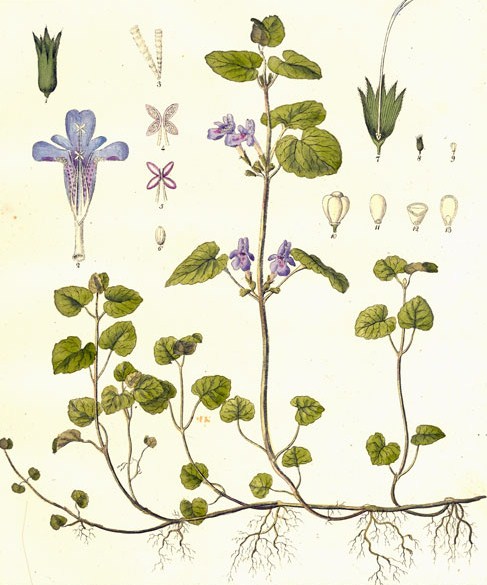
Glechoma hederacea (L)
 Synonyms and Common names: Nepeta hederacea, Hederae terrestris herba,
Nepeta glechoma, Glechoma hederaceae herba, Alehoof, Gill-over-the-ground,
tun-hoof, haymaids, hedgemaids, Lizzy-run-up-the-hedge, Robin-run-in-the-hedge,
catsfoot, cat�s paw, gillrun
Synonyms and Common names: Nepeta hederacea, Hederae terrestris herba,
Nepeta glechoma, Glechoma hederaceae herba, Alehoof, Gill-over-the-ground,
tun-hoof, haymaids, hedgemaids, Lizzy-run-up-the-hedge, Robin-run-in-the-hedge,
catsfoot, cat�s paw, gillrun
German = Gundermann, French = Lierre terrestre, Spanish = Hiedra terrestre, Italian = Edera terrestre
Order: Labiatae
Description: Glechoma is a creeping, rooting, hairy perennial, common in the British Isles (except Scotland), Western Europe, North Asia and Japan. The quadrangular stems are hairy, unbranched, and often purplish. The opposite, long-stalked leaves are up to 4cm long, reniform, hairy and bluntly serrate. The ascending shoots, up to 50cm long, bear pairs of two-lipped pale violet flowers from March to June in the axils of leaf-like bracts. The corolla is 15-20mm long with purple spots on the lower lip. It grows in hedges, woods, shady meadows and damp fields.
Parts used: aerial parts
Collection: Between April and June.
Constituents: Sesquiterpenes (including glechomafuran), flavonoids (principally glycosides of luteolin, apigenin and quercitin), triterpenoids (including ursolic acids, oleanolic acid and beta-sitosterol), a bitter substance (glechomine), phenolic acids, 6-7% polyphenols (�pseudotannins�), 0.03-0.06% volatile oil, saponin, resin, choline, free amino acids.
Actions: mild expectorant, anti-inflammatory, anticatarrhal, astringent, vulnerary, diuretic, stomachic
Indications: chronic respiratory catarrh, bronchitis, coughs, tinnitus, diarrhoea, haemorrhoids, cystitis gastritis. Specifically indicated in chronic bronchial catarrh.
Therapeutics and Pharmacology: Glechoma is primarily used in the treatment of bronchitis and catarrh where it exerts an expectorant action. It is of particular benefit when catarrh has built up in the inner ear, causing tinnitus. Its anti-inflammatory and astringent actions make it a useful remedy in the treatment of diarrhoea and as a topical application for haemorrhoids. Compresses of the infused herb may be applied to inflamed skin. It has also been used effectively in inflammation of the lower urinary tract, particularly cystitis.
The anti-inflammatory and expectorant actions are attributed to the labiate flavonoids. Ursolic and oleanolic acids have been linked with anti-inflammatory, anti-tumour and anti-ulcerogenic activity. A specific unsaturated fatty acid appears to regulate platelet enzyme activity related to prostaglandins.
Glechoma is believed to stimulate the flow of bile and has been used to treat gastric and duodenal ulcers, gallstones and gallbladder disease. It is believed to stimulate the metabolism generally.
Combinations: Glechoma can be combined with Tussilago, Marrubium, Inula and Glycyrrhiza for coughs, or with Hydrastis or Solidago for sinus catarrh.
Caution: Large amounts are toxic to grazing horses, but the herb is safe at therapeutic doses.
Preparation and Dosage: (thrice daily)
GSL Schedule 1
Dried herb: 2-4 g or by infusion
Liquid Extract: 1:1 in 25% alcohol, 2-4 ml.
Tincture: 1:5 in 25% alcohol, 5-10ml
Additional Comments: Galen recommended ground ivy for inflamed eyes, and it has been used in the past to treat lead poisoning in painters. The Anglo-Saxons used it to clarify their beer before hops were introduced, hence the common name alehoof and, in the Tudor period and later, it was added to beer so that it would keep longer on sea voyages. Gerard considered it a valuable remedy for tinnitus. In Chinese medicine it is prescribed for influenza, kidney stones, trauma, rheumatoid arthritis and skin sores. It may be eaten fresh as a vegetable in soups and stuffings.
Bibliography
Bartram, T. 1995 Encyclopedia of Herbal Medicine, 1st edn.,Grace Publishers, Bournemouth.
Bradley, P.R. (ed.) 1992 British Herbal Compendium, Volume 1, BHMA, Bournemouth.
Bremness, L. 1994 Herbs, Dorling Kindersley Eyewitness Handbook, London.
BHMA 1983 British Herbal Pharmacopoeia, BHMA, Bournemouth.
Chevallier, A. 1996 The Encyclopedia of Medicinal Plants, Dorling Kindersley, London.
Gerard, J. 1633 The Herball or Generall Historie of Plantes, Facsimile Edition (1975), Dover Publications, New York.
Grieve, M. 1931 A Modern Herbal, (ed. C.F. Leyel 1985), London.
Hoffmann, D. 1990 The New Holistic Herbal, Second Edition, Element, Shaftesbury.
Lust, J. 1990 The Herb Book, Bantam, London.
Polunin, M. and Robbins, C. 1992 The Natural Pharmacy, Dorling Kindersley, London.
Press, B. & Gibbons, B. 1993 Wild Flowers of Britain and Europe: Photographic Field Guide, New Holland Publishers, London.
Prihoda, A. 1989 The Healing Powers of Nature, Octopus, London.
Rogers, S.K. 1995 British and Chinese Herbal Pharmacopoeia, Healthlink Software Systems, Australia
Wren, R.C. 1988 Potter's New Cyclopaedia of Botanical Drugs and Preparations, C.W.Daniel, Saffron Walden.










